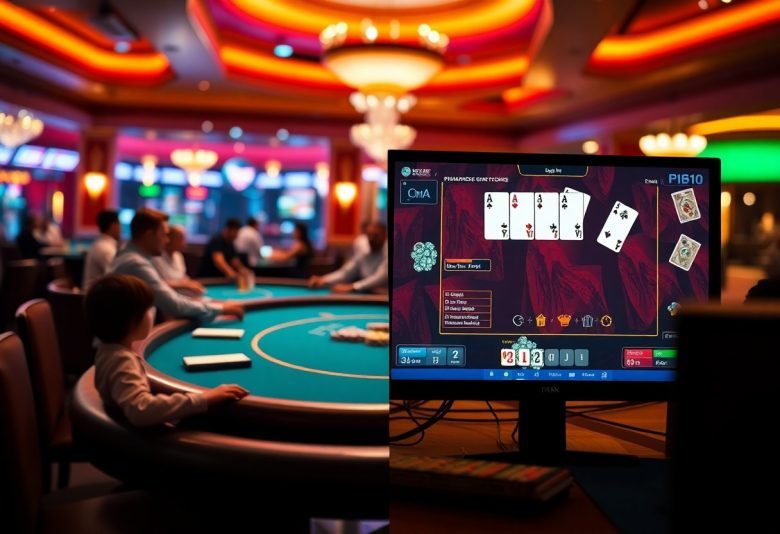You have a choice to make: online poker or live poker? Each format offers unique challenges and opportunities that can greatly affect your game strategy and results. Understanding your own playing style and preferences will help you determine which option best suits your goals. Whether you thrive on the intensity of face-to-face interactions or the convenience of playing from home, your decision matters. In this post, we’ll explore the key differences and help you align your strategy with the right poker style.
Understanding Poker Styles
While each poker player has a unique approach, it’s crucial to recognize the fundamental styles that can influence your gameplay. By understanding these styles, you can develop a strategy that aligns with your strengths, whether you prefer the digital arena of online play or the dynamic environment of live poker. Adapting to your chosen style will empower you to maximize your potential at the table.
Characteristics of Online Poker
Around the online poker scene, you’ll find a fast-paced environment that offers convenience and a wide variety of games. Players can join tables from the comfort of their homes, and the anonymity can sometimes lead to more aggressive strategies. Advanced software tools enhance your ability to analyze patterns and improve your gameplay, but the lack of physical tells can make it challenging to read opponents effectively.
Characteristics of Live Poker
On the other hand, live poker provides a social atmosphere where you can interact face-to-face with opponents. This setting allows you to observe physical tells and engage in the psychological aspects of the game. With a slower pace, it encourages more thoughtful decisions, but the pressure of a live audience can lead to heightened emotions and stress.
Considering the benefits of physical interaction in live poker, you can gain an edge from reading your opponents’ body language and facial expressions. The social dynamics involved often create a more enjoyable experience, and you may find that the emotional highs and lows of live play enhance your passion for the game. However, it’s important to be wary of the influence of distractions and the potential for mistakes when playing in such an environment. Balancing these elements will help you thrive in live settings.
Strategic Considerations
There’s no one-size-fits-all approach when it comes to poker strategy. Your choices should stem from the environment you’re playing in—whether online or live. Each setting has its unique challenges and advantages, requiring you to adapt your tactics accordingly. Understanding the strategic considerations in both formats is necessary for maximizing your effectiveness at the tables.
Table Dynamics in Online Play
Against the fast-paced nature of online play, you must be ready to adjust your strategy on-the-fly. The anonymity can lead to a wide range of player types, making it vital to identify patterns quickly and exploit them for an edge.
Table Dynamics in Live Play
Across live play, the dynamics shift significantly, as you must consider the emotional and psychological elements at play. You get to observe physical tells, such as body language and facial expressions, which can inform your decisions. The pace is slower, allowing for more thoughtful strategic planning and adjustment.
This really enhances your gameplay. The ability to read your opponents through subtle physical cues can provide a significant advantage, allowing you to make more informed decisions. Additionally, the social interactions at the table may lead you to gather valuable insights about your competitors’ tendencies. Engaging in conversations can also create a psychological edge, as it helps to establish a rapport or provoke reactions that inform your strategy. Overall, adjusting to the nuanced environment of live play will greatly enrich your overall poker experience.
Skill Development
The poker landscape offers distinct advantages for skill development, whether you choose online or live play. Each format presents unique challenges and learning opportunities that can enhance your overall game. By understanding these differences, you can tailor your practice to maximize your growth and become a more formidable player.
Learning Curve for Online Players
Curve analysis in online poker shows that you often face a steeper learning curve. You’ll need to adapt quickly to various software tools, odds calculations, and multi-tabling strategies. The speed of play can be overwhelming at first, but it also allows you to gain experience rapidly if you stay focused and dedicated to improving your skills.
Learning Curve for Live Players
Among the key elements of live play is the slow, deliberate pace that can foster deeper strategic thinking. You develop crucial skills, such as reading body language and gauging opponents’ emotions. This slower environment allows you to reflect on your decisions and adaptability amid changing dynamics around the table.
Curve feedback from live play emphasizes your need to develop strong observational skills in addition to traditional strategy. Engaging with players directly opens avenues to learn insights from live interactions. Presence and table atmosphere can also influence your emotional intelligence, making it important to stay vigilant. As you navigate these social dynamics, you will find that success involves manipulating not just your cards but your opponents’ perceptions too. Embrace this aspect to gain a competitive edge.
Psychological Factors
Despite the allure of poker, your success heavily relies on understanding the psychological factors at play. In both online and live formats, players face unique mental challenges that can impact their game. Key points to consider include:
- Emotion management
- Reading opponents
- Discipline
- Focus
Knowing how these elements affect your strategy can significantly enhance your performance.
Online Player Psychology
For online players, the psychological landscape is shaped by a combination of anonymity and distance. Your interactions are devoid of physical cues, making it necessary to rely on statistical data and patterns to guide your decisions.
Live Player Psychology
By contrast, live players must navigate a complex web of interpersonal dynamics. You can read facial expressions and body language, which can provide insights into your opponents’ hands and emotions.
Psychology plays a vital role in live poker settings. You have the ability to use bluffing and reads to gauge your opponents’ intentions. However, the intense atmosphere can also bring about tension and pressure, influencing decision-making. Staying in control of your own emotions is necessary, as losing focus can lead to costly mistakes. In live games, social interactions may offer opportunities to build confidence or allow for misdirection, making your psychological approach a critical element of your overall strategy.
Social Aspects of Poker
To truly excel in poker, understanding the social dynamics of the game is crucial. Each environment, whether online or live, offers distinct opportunities for interaction and community building. These social aspects can greatly influence your strategy and overall experience, enhancing not just your gameplay but also your enjoyment of the game.
Community and Interaction in Online Games
The online poker scene has cultivated vibrant communities where you can interact with players from all over the globe. You can join forums, participate in chat rooms, and engage in social media groups that offer support, strategy sharing, and camaraderie. These interactions can foster a sense of belonging, even when you’re behind a screen.
Community and Interaction in Live Games
An engaging component of live poker is the face-to-face interaction you experience. Sitting at a table with fellow players creates a unique atmosphere where you can gauge reactions, share banter, and build rapport. This interpersonal connection can elevate your game and enrich your poker journey.
Due to the nature of live games, the opportunity for social interaction is profound. You not only compete against opponents but also create bonds over shared experiences. This social engagement can foster lasting friendships and valuable networks within the poker community. Moreover, the ability to read body language and make observant connections often adds another layer of strategy to your gameplay, enhancing your overall poker experience.
Making the Choice
Once again, you find yourself at a crossroads, contemplating whether to examine into the world of online poker or immerse yourself in a live setting. Each option has its distinct advantages and challenges, ultimately shaping your playing experience, strategies, and even your bankroll. The choice you make will influence not only your gameplay but also your overall enjoyment and success in the game.
Evaluating Personal Preferences
By carefully assessing your individual interests, lifestyle, and social tendencies, you can zero in on the poker format that aligns with your personal preferences. Consider factors like your availability, comfort with technology, and whether you thrive in social environments. Understanding what excites you about poker will guide you in making a choice that enhances your experience.
Adapting Strategies to Your Selected Style
Around your chosen poker format, you must also adapt your strategies to align with the unique dynamics of online or live play. Each setting requires distinct skills and tactics that cater to the environment’s nuances, such as table dynamics and player behavior.
At this juncture, shifting your gameplay style to fit the selected format can significantly affect your overall performance. For example, in online poker, you might focus on multitabling and using software tools to analyze trends, while in a live setting, you would benefit from reading physical tells and engaging with opponents to gain insights. Being mindful of the pacing of play is also important; live games typically require more patience, while online formats often demand quick decision-making. Ultimately, honing your strategies to suit your preferred style will enhance your gameplay and success rate.
Summing up
Following this exploration of online and live poker, you should now have a clearer understanding of which style aligns best with your strategy and preferences. Each format offers unique advantages and challenges that can significantly impact your game play. By assessing your skills, objectives, and comfort level, you can make an informed decision that aligns with your personal approach to poker. Whether you choose the fast-paced environment of online games or the social atmosphere of live play, ensure that your choice enhances your overall poker experience.




